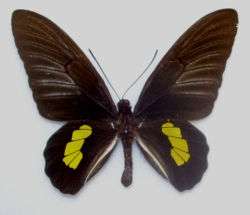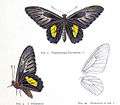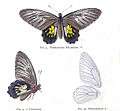Troides haliphron
Troides haliphron, the haliphron birdwing, is a birdwing butterfly confined to Sulawesi and the lesser Sunda Islands.
| Haliphron birdwing | |
|---|---|
 | |
| Male, upperside | |
| Scientific classification | |
| Kingdom: | |
| Phylum: | |
| Class: | |
| Order: | |
| Family: | |
| Genus: | |
| Species: | T. haliphron |
| Binomial name | |
| Troides haliphron (Boisduval), 1836 | |
Description
- For terms see External morphology of Lepidoptera.
Troides haliphron is sexually dimorphic.
Male: The forewings are ground colour black. The veins are bordered by white shading. The hindwings are ground colour black. There is a golden band in the discal area of the wing. The veins are black and they cleave the golden area. The underside is similar.
Female: The female is larger than the male. The ground colour of the female is brown. The veins are bordered by white shading. There is a yellow area with dark veins on the hindwings. There is one chain of black spots is in the yellow area. The underside is similar.
The abdomen is dark brown, and the underside has yellow spots. Head and thorax are black. The nape has a red hair coat.
Taxonomy
Troides staudingeri has at times been considered a subspecies of Troides haliphron.
Subspecies celebensis - the status of this taxon is uncertain. It has been placed within Troides criton, and Troides oblongomaculatus. It may be a hybrid with Troides helena hephaestus.
Subspecies
A number of other subspecies have been described from different islands. They are:
Biology
The larva feeds on species Aristolochia.
Related species
Troides haliphron is a member of the Troides haliphron species group. The members of this clade are:
- Troides haliphron (Boisduval, 1836)
- Troides darsius (Gray, [1853])
- Troides vandepolli (Snellen, 1890)
- Troides criton (C. & R. Felder, 1860)
- Troides riedeli (Kirsch, 1885)
- Troides plato (Wallace, 1865)
- Troides staudingeri (Röber, 1888)
References
- Collins, N. Mark; Morris, Michael G. (1985). Threatened Swallowtail Butterflies of the World: The IUCN Red Data Book. Gland & Cambridge: IUCN. ISBN 978-2-88032-603-6 – via Biodiversity Heritage Library.
- D'Abrera, B. (1975) Birdwing Butterflies of the World. Country Life Books, London.
- Haugum, J. & Low, A.M. 1978-1985. A Monograph of the Birdwing Butterflies. 2 volumes. Scandinavian Press, Klampenborg; 663 pp.
- Kurt Rumbucher and Oliver Schäffler, 2004 Part 19, Papilionidae X. Troides III. in Erich Bauer and Thomas Frankenbach Eds. Butterflies of the World. Keltern: Goecke & Evers ISBN 978-3-937783-02-4
External links
| Wikimedia Commons has media related to Troides haliphron. |
| Wikispecies has information related to Troides haliphron |
- Troides haliphron at Ngypal
- Butterflycorner.net Images from Naturhistorisches Museum Wien (English/German)
- Sulawesi Lowland Rain Forests Ecoregion

